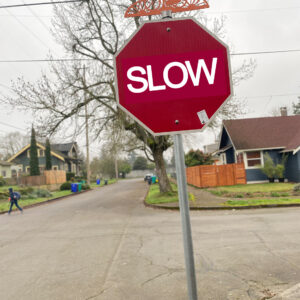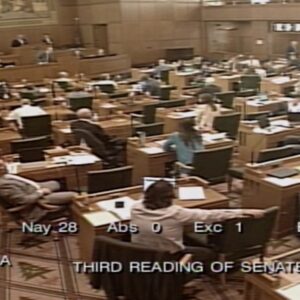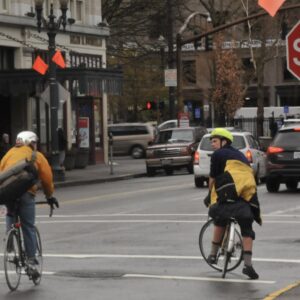https://www.youtube.com/watch?v=LCtqx2HA4N0
For the past 10 months we’ve lived in a state where it’s legal to roll through stop signs and flashing red signals if you’re on a bicycle. It took us 13 years, but due to the always unstoppable combination of dedicated activists and willing politicians, we were finally able to get it done.
And of course, despite all the fear-mongering and rhetoric, the sky has not fallen and we haven’t heard anything bad about the new law since it went into effect.
Advertisement
Now that it’s here to stay and no longer a controversial idea, the Oregon Department of Transportation has added stop-as-yield (AKA Idaho Stop) to their educational and marketing portfolio.
Today ODOT released a video explaining how the new law works. For a state DOT that’s not exactly well-versed in the ways of cycling, it’s actually pretty good. ODOT has the pitch down pat and explains the law like this:
“It allows a person riding a bike to keep some momentum at an intersection while checking for oncoming traffic… This rolling stop helps make the ride more efficient and improves the flow of traffic.”
This is a nice effort from ODOT. For a bit more expanded explanation of why it makes sense for bicycle riders to yield at intersections, I still highly recommend Portlander Spencer Boomhower’s video from 2009 (which has been viewed over 211,000 times!).
— Jonathan Maus: (503) 706-8804, @jonathan_maus on Twitter and jonathan@bikeportland.org
— Get our headlines delivered to your inbox.
— Support this independent community media outlet with a one-time contribution or monthly subscription.






Thanks for reading.
BikePortland has served this community with independent community journalism since 2005. We rely on subscriptions from readers like you to survive. Your financial support is vital in keeping this valuable resource alive and well.
Please subscribe today to strengthen and expand our work.
The urban environment in this video is so hilariously different to anything that ODOT is ever responsible for.
Why, it has buildings right up to the sidewalk, even residential. Looks great! If ODOT were responsible, buildings would be 30′ back, so the poor, errant drivers don’t get hurt when they stray off the road a bit.
I too hate greenery.
Given how this fictional ODOT street isn’t going to become a Traditional City-style street anytime soon, I think it’s reasonable to make the argument that setbacks for greenspace are needed. However, from an idealistic point of view:
https://newworldeconomics.com/place-and-non-place/
“One of the basic problems with Non-Place is that it’s contagious. When you start introducing Non-Places into a city design, you tend to add more and more Non-Places to try to fix the problems caused by the original Non-Places. If you have two Places next to each other, like an apartment building and a store, then you can easily walk from the apartment building to the store. If you put a big roadway in between, now you can no longer walk. You need a car. Now the apartment building needs a parking lot. Now the store needs a parking lot. Now the roadway needs to get bigger because of all the people driving from the apartment to the store. Now you need to surround the apartment building with grass (or better yet, a row of trees) to add a little buffer between the apartment building and the noisy roadway, because who wants to live next to a roaring highway? Then, you need to surround all the parking spaces with more grass and shrubbery, so that you aren’t left with acres of burning asphalt. Then, the apartment building and the store are now so far from each other that you decide you need a freeway system. Then, because you have to drive the on/off ramps at 50 miles per hour, they need to have an enormous radius, and then they need to be surrounded by more green space and probably a cinder block wall so that people can tolerate the endless noise of a major freeway. Then, your city fills up with gasoline stations, car dealers, mechanics, auto parts stores, and all the paraphernalia needed to maintain all this transportation infrastructure. It is quite possible that your portion of Place to Non-Place in the city will fall below 10%. Essentially, the only Places left will be building interiors and a few parks (minus their parking lots).”
So, if I understand properly, to avoid “nonplace” we need to keep our cities no larger than a small village so people can walk to everything they need. And maybe get deliveries by drone.
Walkable streets, walkable places in most of the world, have buildings hugging the sidewalk, and the roadways are narrow too. There are no Setbacks for a planted area behind the sidewalk, which is a suburban concept. In cities you have trees in the streets, and the buildings form the walls of the “outdoor room”. You can call out to someone on the other side of the street with ease. Oh, and there are often green back yards/courtyards (oh, and the deliveries are done these days by tiny delivery vehicles, not the Huge Fedex trucks we see.) This is in small villages like older parts of Amsterdam, e.g.
My neighborhood is quite walkable, and we have plenty of trees and other publically viewable greenery, and I often call to my neighbors across the street. I actually find most of Portland’s residential streets to be quite pleasant and human scale.
European doors are different than in the US, to my understanding, because they swing in to avoid hitting passersby whereas ours swing out to avoid trampling and entrapment during emergency exit. (Or so I was once told).
To Hello Kitty’s comment below, I believe at least one of the pictures in your link is Tokyo. So it’s not just small villages that look like this!
It is a strange city: lots of cars, but no parking nor any driveways. Huge blocks with no homeless and very few pedestrians. No one is looking at their cell phones. The cyclist hasn’t been repeatedly pulled over by police for bicycling while black (and there are no police around). Every street has huge green bike lanes on both sides, wide sidewalks, no parking, no center turn lanes, no food carts, no trash receptacles, all the buildings are well maintained, and there is no graffiti. It’s like a sanitized Disney version of a medium-sized German city.
“No one is looking at their cell phones.”
Last time I got driven around in Japan (Chiba area), the drivers had television shows streaming to screens in their dashboards instead of radios.
I hope this gets a lot of air time. I haven’t been accosted yet for ‘running stops signs’, but I gird my guts for the day I do. I’m also a little tickled that ODOT had to pay for this. 😀
There were a lot of things that I never would have guessed would happen when I started all this, and ODOT making a PSA to explain it to people would for sure be on that list. I think I still like Spencer’s video better, but this one is pretty fun too.
I, too, am surprised that nobody has yelled or honked at me. I’m sure most drivers are not aware of the law change. I was always good about stopping before, just to do my little bit to help the image of cyclists. I mostly like the new law, although I am nervous in those situations where I am arriving at the stop sign at about the same time as a car, and roll through; I am not even sure how the law would be applied in very close timing situations and there is a wreck.
I don’t get the kicked puppy routine that’s so common here. But I guess I should be impressed that everyone isn’t howling that the vid isn’t promoting high motor vehicle speeds given the ones depicted.
Since when was it not overwhelming practice for motor vehicles and cyclists alike to do what the law now allows cyclists to do? If you actually stopped at a sign when it wasn’t necessary before the law was passed, people would get annoyed.
Sure, haters sometimes say/yell something. But if you live in a major metropolitan area, you’ll have all types and this law isn’t going to change that.. Whatever the case, getting yelled at super rare. If it isn’t, you’re doing something and need to figure out what that is — that you actually care about some rando’s approval doesn’t exactly scream out (no pun intended) that you think you’re in the right.
But the vid is nice, and the young guy on the tadpole was a nice touch.
That is pretty condescending. If you ride on streets at all, then you must be familiar with the various ways motorists express their contempt for cyclists; the punishment pass being a very tangible example. One time, I was riding straight through and intersection and a motorist turned across my path. He yelled at me, “turning traffic yeilds”. And I was so confused because he was yelling at me about what he was supposed to do.
What is this nonsense? My post was about how I’m happy that ODOT paid for a PSA, not that I’m worried about approval (least of all yours). You have a very creative, inductive reasoning “skill”.
Are there other states that allow Idaho stops?
Idaho, Delaware, Colorado, Arkansas, and most recently, Washington!
That is a list of states that I didn’t think could ever all be mentioned as agreeing on anything!
Its pretty rare that Arkansas lead Oregon.
(I mean Washington State sure, but Little Rock? Could now be a trend with Rapha etc.)
A shot in the dark here, but: Probably paid (lobbied) for by the Walton family. Wal-Mart HQ is there, and the family are huge supporters of mountain biking, having sponsored a huge trail system there.
Not sure of the legality, but almost no cyclists stopped at intersections when I was riding in San Francisco a few weeks ago. All motor vehicles stopped when they saw me approach an intersection, and seemed surprised when I didn’t just cruise through the intersection at full speed. Aside from the crazy steep hills, San Fran was a great city to ride in!
Aside from that, Mrs. Lincoln, how was the play?
Both SF and CA tried unsuccessfully to pass it, to the outcry of everyone from the general public to Jerry Brown and the CHP, who predicted mass carnage on the streets if it passed. CHP even produced data showing cyclists were “at fault” in the majority of incidents with cars, with majority of the non-fault incidents caused by DUI drivers.
SF, 2015, there are videos online of cyclists staging “stop at stop signs” events showing how badly traffic would back up if everyone stopped – look up “wigg party protest” or “stop-in”.
Also, note this one of SFPD bike-based officers demonstrating the ‘Idaho stop’ technique unintentionally to the public: https://www.youtube.com/watch?v=uL0rkHqOK-4
Mark my word, in 5 years everyone will call this the “Oregon Stop” once it becomes famous, like “Idaho who?! 😉
Or the Salem Slide?
And is this a “video”? or a “cartoon” ?, think about that and discuss amongst yourselves in a socially distant virtual way.
Is that Dr. Fauci in the convertible in the last shot?
It’s a cartoon video.
I am sure that Mark Ginsberg probably agrees that it is interesting that in this video the person is riding an illegal bicycle. Maybe it is time to take another run at the brake bill… https://bikeportland.org/2007/06/19/burdick-axes-fixed-gear-language-from-brake-bill-4094
The person highlighted has a SS with a coaster brake — that’s why she can stop while coasting. Nothing illegal about her rig.
IMO, the bike is too big for her, and the crank arms are way too long.
Wile E. Coyote’s femurs are just completely wrong.
Seat is too low also, but that’s realistic — most people ride bikes that aren’t set up properly for them.
Even when they are, you’ll see goofball choices such as mounting Gatorskins on lightweight carbon fiber wheels
Yep. The rear wheel appears to freewheel briefly and the rider doesn’t shift their weight as a street fixie rider inevitably must.
Watching it again there is a moment where it does appear to freewheel, but she never pedals backward to slow down with a coaster brake just slows the rate at which she pedals giving the impression in one section that it is a fixed gear. This may be the rare example of someone riding a freewheel singlespeed with no brakes of any kind. I hope she has a stick brake for emergencies:: https://bikeportland.org/2006/08/07/messengers-break-out-the-sticks-1797
Never seen a coaster break without the tell-tale arm from the rear hub to the chain stay. Her bike has no such attachment. Maybe newer coaster hubs are keyed to the dropouts like internally geared hubs?
For once in 2020, the story is that there is no story. There’s a complete lack of incidents and outrage. This video may be the first knowledge many people in Oregon have of legal stop-as-yield.
The Idaho Stop is a no-brainer. It makes me feel much more comfortable knowing that I can judiciously roll through a stop while still following common-sense rules.
Lew Frederick fought this bill, big time. Don’t forget this quote on the I5 – “So I have a range of folks… There are some very vocal people who, frankly, believe this is the way to suddenly turn around everything that’s taking place regarding global warming, so you have that kind of constituency as well.”
Yes this summer we did have this conversation. No thanks to Lew Frederick. As per ODOT, stop listening to Fredrick; he doesn’t have deep constituency support and I would encourage a new party Independent ; Working Family Party or other party time start prepping a recall campaign or start running against him now. Push him hard to listen to cyclists or retire. His form of old school politics is no longer appreciated nor wanted. Tina Kotek needs to pull him off all the State Transport committees. He has pushed down cyclists for far too long and we deserve a transport committee that is willing to fight for climate justice solutions. Cyclists aren’t the problem Lew Frederick is the transport problem this state could address by removing Lew from transport decisions. He has lost his moral compass.
I don’t agree that Frederick was a strong opponent of the bill, in fact he voted for it. https://olis.leg.state.or.us/liz/2019R1/Measures/Overview/SB998
Motorists, myself included, have just come to expect that people on bikes roll through intersections, stop signs, red lights, cross walks and anything else in their path. They DON’T follow the same rules that cars do, even though they should and we have all come to just accept it, live with it, and grumble about it. So now, when a bike runs through a stop sign, whether motorists realize it’s legal or not is irrelevant. They have gotten used to putting up with it.
I regularly see cars rolling through stop and yield signs without even slowing down, let alone stopping, especially when making left turns. What really gets me is when a car goes through a red light without stopping – I’ve witnessed numerous crashes and even more close-calls. I’d say driving standards are really slipping lately.
Oregon has a “Delaware” stop sign law. In Idaho, unlike Oregon, a red light can be treated as a stop sign for cyclists. Oregon is like Delaware in that stop signs can be treated as yield signs (not traffic lights!)
We do allow cyclists to proceed through red lights if they can’t trigger them already. I think it was the right move to focus on the stop sign’s only to prevent muddying of the waters. Idaho got their stop sign law first and then added the stop light portion of the law later. I think we will probably see improvements to the stoplight law in a few years to more closely match Idaho.
I’m just happy we have fifty different sets of rules and licenses, not like those silly Germans.
poor folks already drive. Don’t think that they don’t.